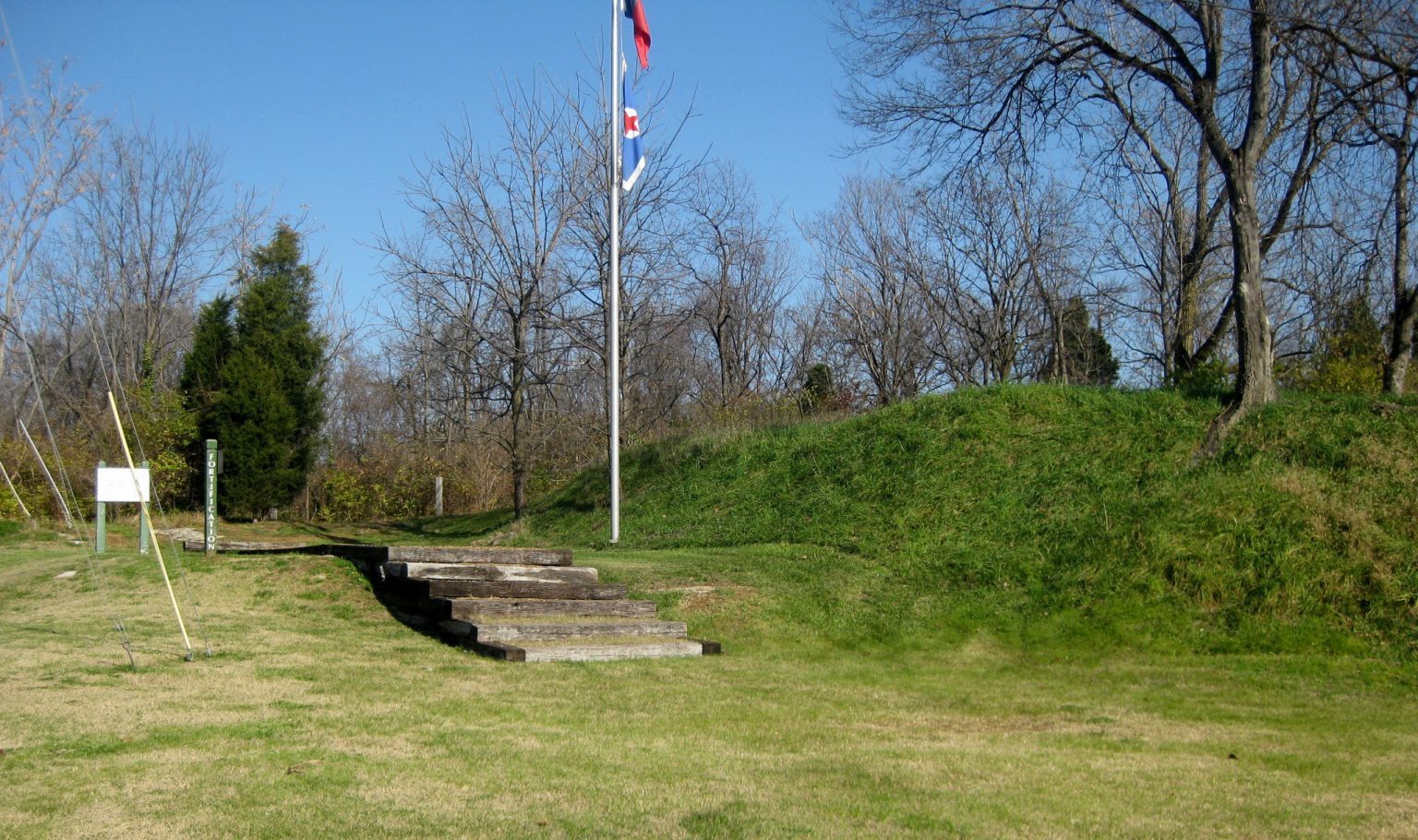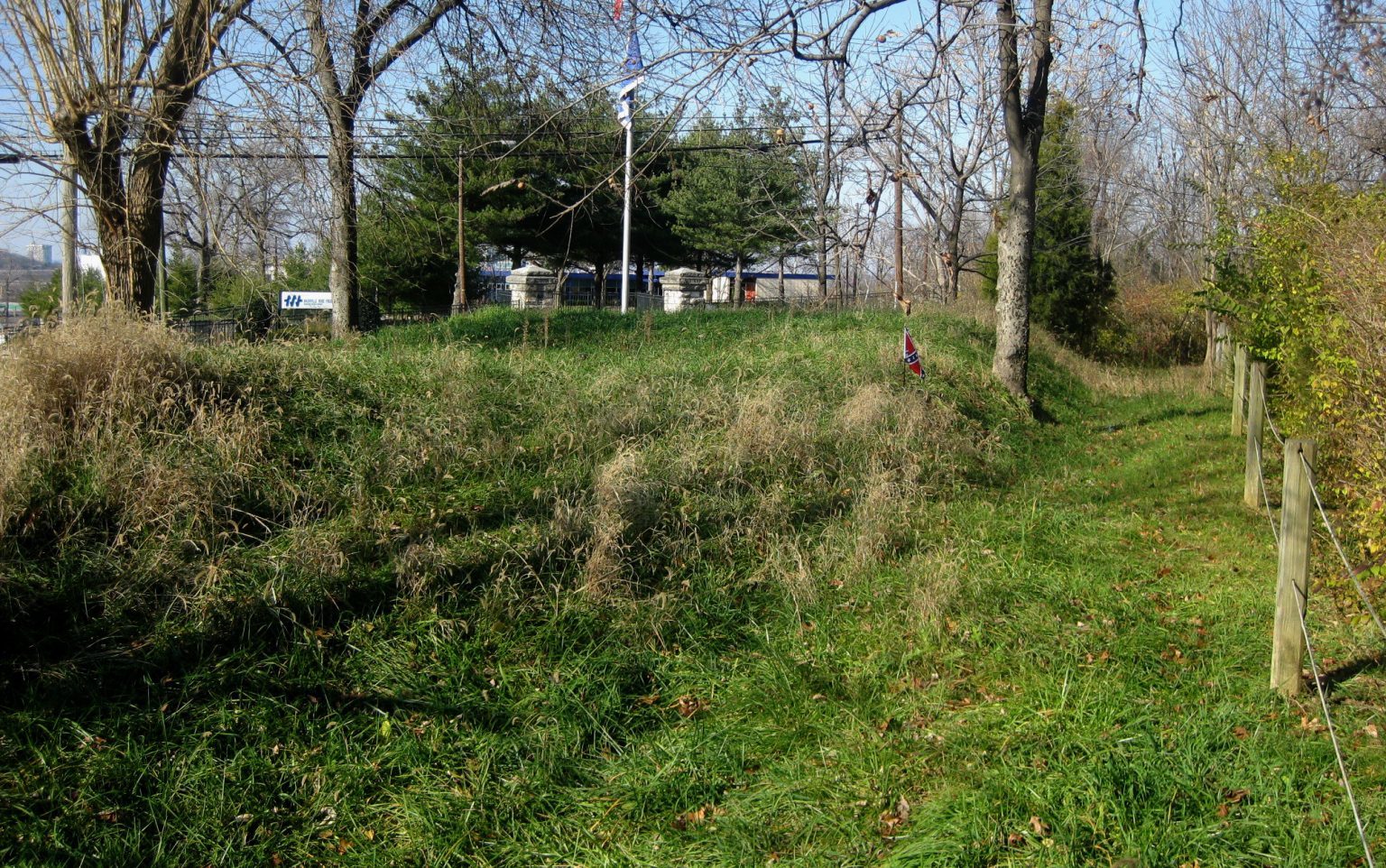Logging requirements are at the bottom of this history of Granburys Lunette.
On December 15, 1864, the Confederate line was anchored on the far right by Granbury’s Lunette. The lunette, a name given to earthen field fortifications which originated in the 17th Century as crescent-shaped outworks, was named after Gen. Hiram B. Granbury, who was killed during the battle of Franklin a couple of weeks earlier. Manning the Confederate right was the Corps of Gen. Benjamin Franklin Cheatham, a Nashvillian who himself happened to be in the lunette on the morning of Dec. 15. The lunette contained 4 artillery pieces and the remaining 344 men of Granbury’s Brigade.

On this first day of battle, Union Gen. George Thomas sent Maj. Gen. James Steedman’s corps against the Confederate right as a feint; the major thrust of the Union attack would come on the far end of the Confederate line, about four miles to the west, with a huge wheeling maneuver by infantry and cavalry.
Steedman’s forces chosen for this assignment involved three brigades. Two of them were regiments of the United States Colored Troops (USCT), consisting of African-American soldiers, many of whom were seeing their first combat since the first recruitment of black troops in 1863. The 1st Colored Brigade consisting of five USCT regiments (14th, 16th, 17th, 18th and 44th) was commanded by Col. Thomas Jefferson Morgan; the 2nd Colored Brigade, consisting of three USCT regiments (12th, 13th and 100th), was commanded by Col. Charles Thompson. The third brigade was commanded by Lt. Col. Charles Grosvenor and was composed of an eclectic assortment of white soldiers whom he described as “new conscripts, convalescents, and bounty-jumpers.” The attacking force totaled about 7,000 infantry and supporting batteries.

Heavy fog enveloped the lunette area when Steedman’s three brigades finally got underway, attempting to flank the Confederate forces from the East in the vicinity of the Murfreesboro Pike. The first advance toward the area of the lunette came from the 1st Colored Brigade. The Southerners were well aware of the advance and allowed the Union troops to penetrate to within extremely close range before unleashing a devastating barrage of rifle fire and canister shot from the four guns within the lunette.
One part of the 1st Brigade had advanced south of the lunette and did not realize they were approaching a deep depression in which lay the tracks of the Nashville & Chattanooga railroad. A horrendous scene unfolded as Cheatham’s troops allowed the Union troops to advance into an inescapable position. When the Confederates sprang their trap, many of the Union soldiers jumped down into the railroad cut. Others had already begun to move into the cut at its far southern opening. Many reports document the broken bones and other injuries resulting from the jump, and of the withering fusillade of fire from Cheatham’s Corps who were poised on the top rims of the railroad cut. The Union brigades suffered significant casualties. Most reports indicate that hundreds of black soldiers were killed in the fight.
The 2nd Brigade, approaching from the North, had become locked into a duel with Confederate forces and stayed that way most of the day. Grosvenor’s brigade was quickly routed after Cheatham’s Corps had dispatched the 1st Brigade at the lunette and railroad cut.
The battle around Granbury’s Lunette was the only Confederate victory on the first day of the Battle of Nashville. The left flank collapsed late in the afternoon as the overwhelming strength of the Union forces was brought to bear. Cheatham’s corps eventually abandoned the lunette and withdrew with the remainder of the Confederate line around 9:00 p.m. They re-formed throughout the night for the second and final day of the battle on December 16, 1864.
It is difficult to record the full meaning of the Battle of the Lunette without recognizing how it was impacted by the relatively rare occurrence of the racial make-up of the combatants. The “Colored Brigades” were heavily represented by former slaves seeing their first combat, while most of their all-white opponents were also seeing black Union soldiers for the first time. That scenario played itself out again the next day in the fierce battle at Peach Orchard Hill. In both encounters, great courage was displayed by both sides.
Long after the Battle of Nashville, Granbury’s Lunette was partially destroyed when a second railroad bed was cut through part of it in the 20th Century. Its remnants – officially located at 190 Polk Avenue — were salvaged by, and are owned by, the Gen. Joseph E. Johnston Camp of the SCV. The preservation was assisted by adjacent McCord Crane Co. Evidence of its earth walls and the infantry ditch that fronted the wall can still be seen. The deadly railroad cut lies about 400 feet West of the lunette, which stands as one of the most important preserved sites of the battlefield.
For a detailed account of this part of the Battle of Nashville, see James Lee McDonough’s excellent book, Nashville – The Western Confederacy’s Final Gamble (2004)
October, 2021
FIRST HISTORICAL MARKER RECOGNIZING THE ROLE OF BLACK TROOPS IN THE BATTLE OF NASHVILLE HAS BEEN ERECTED NEAR GRANBURY’S LUNETTE
The African American troops of the Union army gained formal, public recognition on Oct. 15, 2021, when the Metro (Nashville) Historical Commission erected a marker near Granbury’s Lunette, some 157 years after they clashed on that ground with Confederate troops during the Battle of Nashville.
The marker is the first-ever commemoration of the important and unique role played by African-American troops in the Battle of Nashville.
Some 7,000 Union soldiers consisting mostly of United States Colored Troops (USCT) attacked Confederate forces at the Lunette during the foggy morning hours of Dec. 15, 1864, the opening salvos of the Battle of Nashville. The Lunette, a crescent shaped earthwork manned by about 340 Confederate soldiers, was anchoring the far right flank of the Confederate line.
The two brigades of Black troops, many of them former slaves, had virtually no combat experience. The First Brigade, consisting of five regiments (14th, 16th, 17th, 18th and 44th) and led by Col. Thomas Morgan, was decimated by Confederate troops after they were led into an untenable position that left them exposed to Confederate fire, with devastating consequences. To review more details about the battle at the Lunette and the Confederate right flank, visit the Granbury’s Lunette page on this website.
The historical marker had been in development for years with the work spearheaded by USCT descendant and reenactor Gary Burke, whose great-great-grandfather had been among the USCT ranks on that 1864 morning. His ancestor, Pvt. Peter Bailey, served in the First Brigade, Co. K, 17th USCT Regiment. The marker was placed on Polk Avenue at the intersection of Fiber Glass Road, within sight of the preserved remnants of Granbury’s Lunette. The Lunette is owned and maintained by the Gen. Joseph E. Johnston Camp of the Sons of Confederate Veterans.

This area is maintained by the Sons of the Confederate. Please respect this location and always remember to leave no trace.
LOGGING REQUIREMENTS:
To log this cache as a find please use the message system and tell me what date is shown on the Green Informational sign just beyond the Flag Pole and include a PICTURE of you, your GPS or your group at the African American Historical Marker in your online log.
There's IS a lot to see here but you will need look around and let what you have read take hold and you begin to imagine what took place at the time of battle. The requirements above are not hard to accomplish, much like the original ones.
Thank you for taking the time to visit this virtual cache and its historical Location.
I have changed the cache page from the originally Published one to include all the history above since adopting this Virtual. The original CO brought us here since 2002. She saw the significance that IS this place. The Community agrees by maintaining it and improving it.
Thank-You Murrcat for allowing me to adopt this Virtual from you . You will never know how much this means to me. - Jim Conway